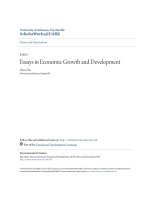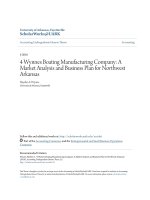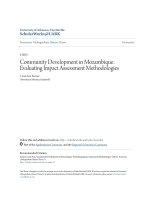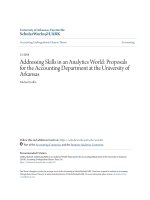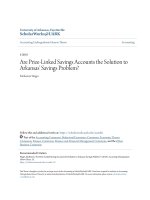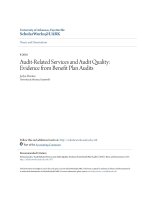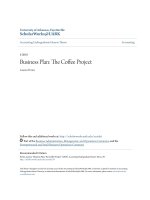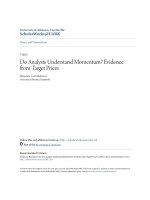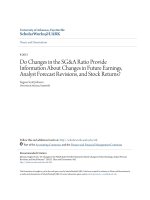Accounting undergraduate Honors theses: Does industry level information affect auditors ’ assessment of client level risk
Bạn đang xem bản rút gọn của tài liệu. Xem và tải ngay bản đầy đủ của tài liệu tại đây (1.03 MB, 102 trang )
University of Arkansas, Fayetteville
ScholarWorks@UARK
Theses and Dissertations
8-2017
Does Industry-level Information Affect Auditors’
Assessment of Client-level Risk?
David Rosser
University of Arkansas, Fayetteville
Follow this and additional works at: />Part of the Accounting Commons, and the Business Administration, Management, and
Operations Commons
Recommended Citation
Rosser, David, "Does Industry-level Information Affect Auditors’ Assessment of Client-level Risk?" (2017). Theses and Dissertations.
2414.
/>
This Dissertation is brought to you for free and open access by ScholarWorks@UARK. It has been accepted for inclusion in Theses and Dissertations by
an authorized administrator of ScholarWorks@UARK. For more information, please contact ,
Does Industry-level Information Affect Auditors’ Assessment of Client-level Risk?
A dissertation submitted in partial fulfillment
of the requirements for the degree of
Doctor of Philosophy in Business Administration with a Concentration in Accounting
by
David Rosser
Drury University
Bachelor of Arts in Accounting, 2007
University of Arkansas
Master of Accountancy, 2013
August 2017
University of Arkansas
This dissertation is approved for recommendation to the Graduate Council.
Dr. Cory Cassell
Dissertation Director
Dr. Linda Myers
Ex-Officio Member
Dr. Jonathan Shipman
Committee Member
Dr. Gary Peters
Committee Member
Abstract
This study investigates auditors’ consideration of industry-level information in their
assessment of client-level risk. Auditing standards suggest that industry-level information is
likely to be important in the assessment of client-level risk, but the standards provide few
specifics about how auditors should use industry-level information in the risk assessment
process. I argue that industry norms serve as a benchmark for evaluating the risk of the client and
that deviations from industry norms could indicate increased audit risk. I create measures that
capture the extent to which clients deviate from industry norms using proxies for client-level risk
factors. In my primary tests, I investigate whether auditors respond to these measures of
deviation from industry norms and whether these measures are associated with adverse audit
outcomes. I find consistent evidence of a positive relation between these measures and audit fees,
suggesting that auditors identify and respond to deviations from industry norms. I find limited
evidence of a relation between these measures and the likelihood of misstatement, suggesting
that auditors’ response to deviations from industry norms is generally appropriate. In subsequent
tests, I consider whether auditors’ response to deviations from industry norms varies by auditor
type. I find that Big Four auditors and industry specialist auditors are more responsive to
deviations from industry norms than non-Big Four and non-specialist auditors. Consistent with
this, I also find some evidence that deviations from industry norms for certain risk factors are
more strongly associated with adverse outcomes for non-Big Four or non-specialist auditors
relative to Big Four or specialist auditors. My findings should be of interest to auditors,
regulators, and market participants because they suggest that identifying and responding to
industry-level information when assessing client-level risk is an important component of
effective audit risk assessment.
Acknowledgments
I would like to thank my committee: Cory Cassell (Director), Linda Myers, Gary Peters,
and Jonathan Shipman. I would also like to thank Joshua Hunt, Kevin Butler, Stuart Dearden,
and workshop participants at the University of Arkansas, the University of Missouri, Auburn
University, Illinois State University, the University of Texas at Arlington, and Texas Tech
University for helpful comments and suggestions.
Table of Contents
I. Introduction ............................................................................................................................... 1
II. Prior Literature and Hypotheses............................................................................................ 7
III. Variable Construction, Research Design, and Sample ..................................................... 11
Variable Construction ............................................................................................................... 11
Research Design ....................................................................................................................... 15
Sample ...................................................................................................................................... 19
IV. Primary Analyses.................................................................................................................. 20
Descriptive Statistics................................................................................................................. 20
Main Tests................................................................................................................................. 22
Big Four Auditors ..................................................................................................................... 25
Industry Specialist Auditors...................................................................................................... 29
V. Additional Analyses ............................................................................................................... 33
Magnitude of the Deviations..................................................................................................... 33
Deviations Measured Using Industry Means ............................................................................ 35
Mid-tier Auditors ...................................................................................................................... 36
National Industry Specialist Auditors ....................................................................................... 39
VI. Conclusion ............................................................................................................................. 41
References .................................................................................................................................... 44
Appendix A .................................................................................................................................. 47
Tables ........................................................................................................................................... 52
I. Introduction
The purpose of this study is to investigate whether auditors respond to industry-level
information in their assessment of client-level risk and how this response affects audit
outcomes.1 Auditing standards require auditors to consider risks of material misstatement from a
variety of sources, including conditions in the company’s industry, when assessing risk (PCAOB
AS 2110). Moreover, the risk assessment process requires auditors to “obtain an understanding
of the company and its environment… to understand the events, conditions, and company
activities that might reasonably be expected to have a significant effect on the risks of material
misstatement. Obtaining an understanding of the company includes understanding… relevant
industry, regulatory, and other external factors” (PCAOB AS 2110, par 7). While this suggests
that standard setters view industry-level information as important in the assessment of clientlevel risk, the standards provide auditors with little guidance about how industry-level
information should affect the risk assessment process and what types of industry-level
information are likely to be important.
I propose that one way that auditors may use industry-level information is as a
benchmark, or norm, against which to compare their clients when evaluating audit risk. In
particular, I expect industry-level information to be important when client-level risk factors
deviate from industry norms.2 Accordingly, I create measures that capture the extent to which
clients deviate from industry norms using client characteristics that prior literature finds to be
I use the terms risk, client-level risk, and audit risk to refer to the risk that the financial
statements of an audit client are materially misstated.
2
My argument is similar to Brazel, Jones and Zimbelman (2009), who find that auditors can use
the difference between financial and nonfinancial measures to help identify fraud companies. I
posit that the difference between client-level and industry-level information can help auditors
assess the risk of material misstatement more appropriately.
1
1
associated with risk (i.e., risk factors).3 I create three separate measures that allow the effect of
these risk factors to vary according to the magnitude of the deviation from industry norms. First,
I create a continuous measure of the magnitude of deviation from the industry median for each
company and standardize the deviation by industry-year. Second, because I expect that the effect
of deviation may be more evident for companies that are substantially riskier than industry
norms, I create indicator variables set equal to one if the client is in the top tercile of my measure
of deviation for each risk factor, and zero otherwise. Third, because I expect the effect of
deviation to be more evident for companies that are riskier than industry norms across multiple
risk factors, I create a count variable of the total number of top tercile indicators the client has.
In my primary tests, I investigate whether these measures of deviation from industry
norms are associated with audit fees and with the likelihood of misstatement. If deviations from
industry norms indicate increased risk and auditors respond appropriately, they should affect the
nature, timing, and extent of substantive audit procedures performed (i.e., auditors should
increase effort).4 However, if auditors fail to respond appropriately, theory suggests that the
likelihood of misstatement will be higher for companies that deviate from industry norms.
The specific risk factors that I use to create my measures of deviation are stock returns, return
volatility, financial distress estimated using Altman’s (1968) model as modified by Shumway
(2001), and leverage. I multiply stock returns and Altman’s Z-Score by negative one so that
increases in each risk factor represent increases in risk. It is important to note that I do not
suggest that these are the only risk factors that might be relevant to auditors. As discussed in
Sections II and III, I choose these risk factors because they are widely available for sample
companies, are commonly used in accounting research, and allow me to develop expectations
about the direction of the effect that deviation from industry norms is likely to have on audit fees
and on the likelihood of misstatement.
4
Alternatively, auditors may respond to increased risk by charging a risk premium. However,
because auditing standards require auditors to respond to increased risk by changing procedures,
charging a risk premium alone would not be an appropriate response. My results are generally
consistent with increased audit fees proxying for increased audit effort, although I cannot rule
out this alternative explanation.
3
2
Accordingly, I follow prior auditing research and use audit fees to proxy for audit effort (e.g.,
Hogan and Wilkins 2008; Cao, Myers and Omer 2012) and I use the likelihood of misstatement
to proxy for the appropriateness of auditors’ risk assessments. My models include controls for a
number of client, auditor, and industry characteristics that have been shown to be associated with
audit fees and the likelihood of misstatement.
Results from my audit fee models indicate that audit fees are positively associated with
deviations from industry norms, particularly for clients in the top terciles of my measures of
deviation. I also find that audit fees are higher when clients deviate from industry norms across
multiple risk factors. These findings suggest that auditors respond to risk reflected in deviations
from industry norms by charging higher audit fees.
Results from my misstatement models are weaker. I find an increased likelihood of
misstatement for companies that are riskier than industry norms across multiple risk factors but
not for my other measures of deviation. However, the limited evidence that deviations from
industry norms are associated with adverse audit outcomes may indicate that auditors’ response
to deviations from industry norms (as suggested by the audit fee results) mitigates the effect of
these risk factors on the likelihood of misstatement.
One approach to investigating whether auditors’ response mitigates the relation between
the likelihood of misstatement and deviations from industry norms is to identify auditors that are
more responsive to deviations from industry norms than other auditors and to examine whether
this increased responsiveness is associated with a decreased likelihood of misstatement.
Accordingly, I examine whether auditors’ response to deviations from industry norms and the
effects of these deviations on audit outcomes vary by auditor type. Prior research finds that Big
Four auditors (i.e., Deloitte & Touche LLP, Ernst & Young LLP, KPMG LLP, and
3
PricewaterhouseCoopers LLP) provide higher quality audits than non-Big Four auditors (e.g.,
Francis, Maydew and Sparks 1999; Lennox and Pittman 2010; and Eshleman and Guo 2014).
Prior research also finds that industry specialist auditors provide higher quality audits than nonspecialist auditors (e.g., Craswell, Francis and Taylor 1995; Balsam, Krishnan and Yang 2003;
and Reichelt and Wang 2010). Moreover, Big Four auditors and industry specialist auditors may
have more exposure to companies in an industry and have access to more, or higher quality,
industry information than other auditors. Accordingly, I posit that Big Four and industry
specialist auditors may be more likely to identify and respond to deviations from industry norms.
Because of this, I re-estimate my audit fee and misstatement models after including interactions
between my measures of deviation from industry norms and indicators for auditor type.
My results for Big Four auditors indicate that the positive association between audit fees
and deviations from industry norms is primarily driven by Big Four auditors. The incremental
effect of Big Four auditors is also stronger for clients in the top terciles of my measures of
deviation from industry norms and for clients that deviate from industry norms across multiple
risk factors.
Consistent with my primary tests, the results from my misstatement models are weaker
than the results from my audit fee models. However, I find some evidence of a positive relation
between deviations from industry norms and adverse audit outcomes for companies with non-Big
Four auditors but not for companies with Big Four auditors. Specifically, the continuous version
of the leverage deviation measure is positively and significantly associated with the likelihood of
misstatement for non-Big Four auditors while the interaction between Big Four and the leverage
deviation measure is negative and significant. Moreover, the sum of the coefficients on the
leverage deviation measure and the interaction term is not statistically different from zero. This
4
provides evidence that Big Four auditors are effectively able to mitigate the negative effects of
deviations from industry norms on audit outcomes for certain risk factors.
My results for industry specialist auditors are similar. They indicate that the positive
association between audit fees and deviations from industry norms is primarily driven by
industry specialist auditors and is stronger for clients in the top terciles of my measures of
deviation and for clients that deviate from industry norms across multiple risk factors.
I also find evidence that industry specialist auditors are able to mitigate the negative
effects of deviations from industry norms on audit outcomes. Specifically, the continuous version
of the leverage deviation measure is positively and significantly associated with the likelihood of
misstatement for non-specialist auditors while the interaction between industry specialist and the
leverage deviation measure is negative and significant. As for Big Four auditors, the sum of the
coefficients on my leverage deviation measure and the interaction term is not statistically
different from zero, providing evidence that industry specialist auditors are also able to mitigate
the negative effects of deviations from industry norms on audit outcomes for certain risk factors.
In additional analyses, I investigate whether the results from the primary analyses are
sensitive to using alternative specifications of the variables of interest and alternative
specifications of auditor types. First, I use measures of deviation from industry norms that allow
for differences in the relative magnitude of the deviation between industries. The primary
analyses use measures of deviation that are standardized so that the relative distance of a
company from the industry median is comparable between industries. Second, I use measures of
deviation from industry norms that use the mean instead of the median as the industry
benchmark. Overall inferences are unchanged when using these alternative measures of deviation
from industry norms. Third, I use a large auditor indicator that combines the largest mid-tier
5
auditors with Big Four auditors. The results of these tests suggest that the increased
responsiveness of large auditors is primarily driven by Big Four auditors. Fourth, I identify
industry specialist auditors using the national industry market. The primary analyses identify
industry specialist auditors using the Metropolitan Statistical Area (MSA) industry market. The
results from these tests suggests that, similarly to MSA industry specialists, national industry
specialists are more responsive to deviations from industry norms than other auditors but they
provide little evidence that this response is associated with the likelihood of misstatement.
This study makes several contributions to the literature. First, to the best of my
knowledge, this is the first study to directly investigate whether auditors consider industry-level
information in their risk assessment. While prior literature generally includes industry indicators
in audit fee models to control for time-invariant differences in audit fees across industries, I
argue that client-specific deviations from industry norms are likely an important, though
overlooked, input in auditors’ risk assessment processes and pricing decisions. Second, to the
best of my knowledge, this is the first broad archival study to investigate whether deviations
from industry norms affect audit outcomes. Auditing standards have long required auditors to
consider industry factors during risk assessment, suggesting that consideration of industry
information is important for risk assessments to be appropriate. Further, prior case studies
provide evidence that failure to obtain and use knowledge of an audit client’s industry can
contribute to audit failures (Erickson, Mayhew, and Felix 2000). However, prior literature does
not provide large sample evidence about whether deviations from industry norms are typically
indicative of increased audit risk. Third, this study contributes to the research that investigates
the effects of auditor type on audit quality. The evidence presented here suggests that greater
6
attention to deviations from industry norms may be a mechanism contributing to the higher audit
quality documented by prior research for Big Four and industry specialist auditors.
My findings should be of interest to auditors, auditing standard setters, and regulators.
The evidence presented here suggests that while auditors’ response to deviations from industry
norms is generally appropriate, smaller, non-specialist, auditors may be able to improve their risk
assessment processes (and audit outcomes) by focusing more carefully on deviations from
industry norms as an indicator of increased client risk. My findings also suggest that additional
guidance about the types of industry information that are likely to be useful and how to
incorporate this industry information in the risk assessment process may help auditors,
particularly smaller and non-specialist auditors, reduce the likelihood of adverse audit outcomes.
The remainder of the paper proceeds as follows. Section II discusses relevant prior
literature and develops the hypotheses, Section III describes variable construction, research
design, and the sample, Section IV presents the primary analyses, Section V presents additional
analyses, and Section VI concludes.
II. Prior Literature and Hypotheses
While auditors are required to consider industry-level information in their client-level
risk assessments, the standards provide almost no guidance about the types of industry
information that are likely to be important or how auditors should use industry information in
their assessment of risk. I propose that one way auditors may use industry-level information is as
a benchmark, or norm, against which to compare their clients. My argument is similar to Brazel
et al. (2009), who investigate whether auditors can use the difference between financial and
nonfinancial measures to help identify fraud companies. I posit that auditors can use differences
between client-level and industry-level information to help assess audit risk. Prior case studies
7
provide evidence consistent with this notion. Erickson et al. (2000) examine the audit procedures
applied to specific transactions from the Lincoln Savings and Loan (LSL) audit failure and
conclude that “applying knowledge of LSL’s business, the real estate industry, and economic
trends in that industry would have been the most effective audit procedures available to LSL’s
auditors” (p. 189).5
However, identifying appropriate company characteristics to use to measure differences
between client-level and industry-level information is problematic because expectations about
how these deviations are likely to affect audit risk are idiosyncratic (and consequently
ambiguous) for many financial characteristics. 6 For example, revenue is a likely candidate as an
important financial characteristic because the auditing standards require auditors to presume that
there is a fraud risk involving improper revenue recognition (PCAOB AS 2110, par 68).
Accordingly, revenue growth that exceeds the industry norm by a large degree might suggest
improper revenue recognition (which increases audit risk). Alternatively, it might indicate that
the company is a strong performer in its industry (e.g., Apple). Similarly, return on equity or
assets, inventory turnover, and gross margin are important characteristics in many industries, but
in all cases, it is difficult to empirically disentangle whether exceeding the industry norm
suggests increased risk or strong performance.
Because of this, I choose company characteristics that prior research has found to be
associated with general business risk and with risk related to the financial condition of a
The authors examined audit workpapers and deposition transcripts related to the 1987 audit of
LSL. LSL’s auditors were subsequently sued (and settled) for failing to prevent the release of
materially misstated financial statements.
6
The relation between the risk factors that I use and audit risk is likely also ambiguous in some
cases. However, I expect that the signal provided by these risk factors about audit risk generally
runs in one direction.
5
8
company. The risk assessment standards explicitly acknowledge that business risk can lead to
risk of material misstatement and require auditors to identify and respond appropriately to
relevant business risks (PCAOB AS 2110). Specifically, the risk factors that I use are stock
returns (Kinney and McDaniel 1989; Tan and Young 2015), return volatility (Erickson, Hanlon,
and Maydew 2006), financial distress, and leverage (Kinney and McDaniel 1989; DeFond and
Jimbialvo 1991; and Burns and Kedia 2006). I expect that companies with stock returns that are
lower than industry norms, companies with return volatility that is higher than industry norms,
and companies that are more financially constrained than industry norms are associated with
increased audit risk.
Following prior auditing research, I use audit fees to proxy for audit effort (e.g., Hogan
and Wilkins 2008; Cao et al. 2012). While specific audit procedures are unobservable, prior
studies with available audit hours, audit fees, and labor experience mix suggest that audit fees
reflect audit effort and are associated with auditors’ response to client risk. For example, Bell,
Landsman, and Shackelford (2001) find that auditors respond to company-level risk by
increasing audit hours. More recently, Knechel and Schelleman (2010) find that auditors respond
to high levels of short-term accruals by increasing audit hours of the professional staff and by
using more supervisor, assistant, and support time. Accordingly, I interpret increased audit fees
for companies that are relatively more risky than their industry as evidence of increased effort,
suggesting that auditors identified and responded to risks reflected in deviations from industry
norms. This leads to my first hypothesis (stated in the alternative):
H1:
Companies that deviate from industry norms pay higher audit fees than other
companies.
I also expect that companies that are more risky than their industry are more likely to
misstate their financial statements than other companies, unless the auditor appropriately
9
identifies and responds to risks reflected in deviations from industry norms. I use the likelihood
of misstatement to proxy for the appropriateness of auditors’ response because a misstatement
indicates that the auditor issued an unqualified opinion on financial statements that were
materially misstated (DeFond and Zhang 2014), indicating that they either failed to identify or
failed to respond appropriately to audit risk. This leads to my second hypothesis (stated in the
alternative):
H2:
Companies that deviate from industry norms are more likely to misstate their
financial statements than other companies.
I also investigate whether auditors’ response to deviations from industry norms varies by
auditor type. Prior research finds that Big Four auditors provide higher quality audits than nonBig Four auditors. For example, prior literature indicates that, relative to companies audited by
non-Big Four auditors, companies audited by Big Four auditors have lower levels of
discretionary accruals (Francis et al. 1999), are less likely to engage in fraudulent financial
reporting (Lennox and Pittman 2010), and are less likely to issue financial statements that are
subsequently restated (Eshleman and Guo 2014). Big Four auditors also have more resources
than non-Big Four auditors and may have access to more, or higher quality, industry-level
information. Accordingly, I posit that Big Four auditors are more likely to be responsive to
deviations from industry norms than non-Big Four auditors and that deviations from industry
norms are likely to be less strongly associated with the likelihood of misstatement for Big Four
auditors than for other auditors. This leads to my third and fourth hypotheses (stated in the
alternative):
H3:
Companies that deviate from industry norms pay higher audit fees when they have
a Big Four auditor than when they have a non-Big Four auditor.
10
H4:
Companies that deviate from industry norms are less likely to misstate their
financial statements when they have a Big Four auditor than when they have a
non-Big Four auditor.
Prior research also finds that industry specialist auditors provide higher quality audits
than non-specialist auditors. For example, prior literature finds that auditors develop reputations
as industry experts (Craswell et al. 1995), that companies with industry specialist auditors have
lower levels of discretionary accruals and higher earnings response coefficients than other
companies (Balsam et al. 2003), and that companies with industry specialist auditors are less
likely to just meet or beat analysts’ earnings forecasts and are more likely to be issued a going
concern audit opinion than other companies (Reichelt and Wang 2010). In addition, industry
specialist auditors may be more responsive to industry-level information because industry
specialist auditors necessarily have greater exposure to the client’s industry than non-specialist
auditors. Intuitively, auditors specializing in an industry are also likely to be more aware of, and
more attentive to, industry-level information than other auditors. For these reasons, my
predictions for industry specialist auditors are similar to those for Big Four auditors, leading to
my fifth and sixth hypotheses (stated in the alternative):
H5:
Companies that deviate from industry norms pay higher audit fees when they have
an industry specialist auditor than when they have a non-specialist auditor.
H6:
Companies that deviate from industry norms are less likely to misstate their
financial statements when they have an industry specialist auditor than when they
have a non-specialist auditor.
III. Variable Construction, Research Design, and Sample
Variable Construction
My variables of interest capture the extent to which certain client characteristics that prior
literature finds to be associated with risk (i.e., risk factors) deviate from industry norms. These
risk factors are the company’s stock return, return volatility, financial distress, and leverage. I
11
choose these risk factors because they are widely available from commonly used databases, they
are used in prior accounting literature as proxies for different aspects of company risk, and,
importantly, because they allow me to develop expectations about the direction of the effect that
distance from industry norms is likely to have on audit fees and on the likelihood of
misstatement. However, I do not suggest that these are the only client characteristics or risk
factors likely to be relevant to auditors, only that they are reasonable proxies for client risks that
are likely to affect audit risk.
For each risk factor, I create three separate measures that allow the effect of the risk
factor to vary according to the magnitude of the deviation from industry norms. First, I create a
continuous measure of the magnitude of the standardized deviation from the industry median by
fiscal year, as follows:7
(Varit median(Varjt ))
DevVarit
.
median _ std (Varit ) jt
Where: i indicates a company, j indicates a three-digit NAICS industry, and t indicates the fiscal
year. I require each industry-year to have at least ten observations for calculating the industry
median for each risk factor to help ensure that the median isn’t unduly influenced by specific
companies and is representative of the industry as a whole. 8,9 I use the three-digit level of
Subtracting the industry average (whether the median or mean) is mathematically similar to
including industry fixed effects in a regression model. However, including industry fixed effects
alone is problematic for several reasons: The coefficients cannot be interpreted as the effect of
deviation from industry norms because the variables in the regression model are demeaned
across multiple dimensions (all other indicator variables included in the models), industry fixed
effects don’t allow for variation over time because they use the mean for the entire sample
period, and, most importantly, including the client-specific risk factors as separate control
variables is necessary to ensure that my measures are capturing the effect of deviation from the
industry rather than the effect of the risk factors themselves.
8
Inferences are generally unchanged if I use the industry mean instead of the median. I present
and discuss analyses using the industry mean in Section V, Additional Analyses.
9
This is similar to the requirement imposed in prior literature for calculating abnormal accruals.
7
12
industry detail because this allows me to retain a large sample of companies while requiring ten
observations for each industry-year.10 I use the NAICS industry classification because anecdotal
evidence suggests that auditors have access to, and presumably use, industry reports prepared for
NAICS industry classifications.11 I standardize the variables because the dispersion of the
underlying risk factors varies across industries and I want the relative distance of a company
from the industry median to be comparable between industries. I modify the typical calculation
of standard deviation to use the median instead of the mean as follows:
| Varit median(Varjt ) |2
median _ std (Varit ) jt
.
n
I create a separate deviation measure for each risk factor by replacing Var in the equation with
the appropriate risk factor. Specifically:
Dev Ret =
Var is replaced with Ret, the company’s raw return for the year,
multiplied by negative one;
Dev Vol =
Var is replaced with Vol, the standard deviation of the company’s
daily stock returns over the prior year;
Dev ZScore =
Var is replaced with ZScore, the company’s financial distress score,
multiplied by negative one (estimated using Altman’s [1968] model
as modified by Shumway [2001]: ZScore = [1.2*WC/TA +
0.6*RE/TA + 10.0*EBIT/TA + 0.05*ME/TL - 0.47*S/TA]*[-1],
where WC is current assets minus current liabilities, TA is total
assets, RE is retained earnings, EBIT is earnings before interest and
taxes, ME is the end-of-year share price times total common shares
outstanding, and S is total revenue); and
As an alternative, I run my tests using a five-digit NAICS classification and requiring five
observations per industry-year for calculating the industry median for each risk factor (sample
attrition is significant if I require ten observations per industry-year). Inferences are unchanged
using this alternative classification.
11
IBISWorld, a large provider of industry reports, claims that 65 of the top 100 CPA firms
subscribe to their industry reports, prepared using the NAICS industry classification. I also had
the opportunity to interview an industry analyst for PricewaterhouseCoopers LLP, who indicated
that they also use the NAICS classification for their in-house industry reports.
10
13
Dev Lev =
Var is replaced with Lev, the company’s total liabilities divided by
average total assets.
Ret and ZScore are multiplied by negative one in order to facilitate the interpretation of the sign
of coefficients so that larger values of Ret indicate lower returns and larger values of ZScore
indicate greater financial distress.
Second, because I expect that the effect of deviation from industry norms may be more
evident for companies that are substantially riskier than industry norms, I create indicator
variables set equal to one if the company is in the top tercile of the measure of deviation by fiscal
year for each risk factor, and zero otherwise. Specifically:
Trc Dev Ret =
an indicator variable set equal to one if the company’s Dev Ret is in
the top tercile of the sample distribution by fiscal year, and zero
otherwise;
Trc Dev Vol =
an indicator variable set equal to one if the company’s Dev Vol is in
the top tercile of the sample distribution by fiscal year, and zero
otherwise;
Trc Dev ZScore =
an indicator variable set equal to one if the company’s Dev ZScore is
in the top tercile of the sample distribution by fiscal year, and zero
otherwise; and
Trc Dev Lev =
an indicator variable set equal to one if the company’s Dev Lev is in
the top tercile of the sample distribution by fiscal year, and zero
otherwise.
Third, because I expect that the effect of deviation from industry norms may be more evident for
companies that are riskier than industry norms across multiple risk factors, I create a count
variable of the total number of top tercile indicators that the client has. Specifically:
Count Trc Dev =
the count of the company’s top tercile indicators (Trc Dev Ret, Trc
Dev Vol, Trc Dev ZScore, and Trc Dev Lev).
14
Research Design
To begin my investigation of auditors’ response to deviations from industry norms, I
model audit fees as a function of my measures of deviation from industry norms and other
determinants common to prior audit fee literature using OLS regression (e.g., Francis, Reichelt,
and Wang 2005; Hay, Knechel, and Wong 2006; and Fung, Gul, and Krishnana 2012). 12
Ln Feesit =
β0 + β1Retit + β2Volit + β3ZScoreit + β4Levit + β5Dev Retit +
β6Dev Volit + β7Dev ZScoreit + β8Dev Levit + β9Ln ATit +
β10Ln Revit + β11Currit + β12FCFit + β13CF Volit + β14Rev Volit +
β15Ln Segit + β16Foreignit + β17Lossit + β18GCOit + β19Busyit +
β20BigNit + β21Mergeit + β22Mat Weakit + β23Ind Herfit +
β24Au Herfit + β25CLeadit + β26Short Tenit + βjYearFE +
βjIndustryFE + εit
(1)
where, for company i and year t: Dev Ret, Dev Vol, Dev ZScore, and Dev Lev are as previously
described. And where:
Ln Fees =
the natural log of the company’s total audit fees;
Ret =
the company’s raw return for the year, multiplied by negative one;
Vol =
the standard deviation of the company’s daily stock returns over the
prior year;
ZScore =
the company’s financial distress score, multiplied by negative one
(estimated using Altman’s [1968] model as modified by Shumway
[2001]: ZScore = [1.2*WC/TA + 0.6*RE/TA + 10.0*EBIT/TA +
0.05*ME/TL - 0.47*S/TA]*[-1], where WC is current assets minus
current liabilities, TA is total assets, RE is retained earnings, EBIT is
earnings before interest and taxes, ME is the end-of-year share price
times total common shares outstanding, and S is total revenue);
Lev =
the company’s leverage (total liabilities divided by average total
assets);
Ln AT =
the natural log of the company’s total assets ($ millions);
Ln Rev =
the natural log of the company’s total revenue ($ millions);
Standard errors are robust and are adjusted for clustering by company in all models (Peterson
2009).
12
15
Curr =
the company’s current ratio (current assets divided by current
liabilities);
FCF =
the company’s free cash flows (cash flows from operations less
capital expenditures divided by current assets);
CF Vol =
the standard deviation of the company’s net operating cash flow over
the prior three years;
Rev Vol =
the standard deviation of the company’s total revenue over the prior
three years;
Ln Seg =
the natural log of the count of the company’s business and
geographic segments;
Foreign =
an indicator variable set equal to one if the company reports foreign
pretax income, and zero otherwise;
Loss =
an indicator variable set equal to one if the company reports a net
loss, and zero otherwise;
GCO =
an indicator variable set equal to one if the company receives a
going-concern audit opinion, and zero otherwise;
Busy =
an indicator variable set equal to one if the company has a December
fiscal year-end, and zero otherwise;
BigN =
an indicator variable set equal to one if the company is audited by
Deloitte & Touche LLP, Ernst & Young LLP, KPMG LLP, or
PricewaterhouseCoopers LLP, and zero otherwise;
Merge =
an indicator variable set equal to one if the company reports sales
from acquisitions, and zero otherwise;
Mat Weak =
an indicator variable set equal to one if the company has one or more
material weaknesses in internal control identified under SOX 302 or
SOX 404, and zero otherwise;
Ind Herf =
company Herfindahl concentration in the industry, calculated as
n
i 1
si 2 ,
where i is a company and s is market share calculated using revenue.
An industry is defined as a three-digit NAICS industry;
16
Au Herf =
auditor Herfindahl concentration in the industry, calculated as
n
i 1
si 2 ,
where i is an audit firm and s is market share calculated using audit
fees. An industry is defined as a three-digit NAICS industry;
CLead =
an indicator variable set equal to one if the auditor has more than
33.3 percent of all audit fees in the company’s three-digit NAICS
industry and Metropolitan Statistical Area (MSA), and zero
otherwise;
Short Ten =
an indicator variable set equal to one if the company’s audit is a
first-, second-, or third-year engagement, and zero otherwise;
YearFE =
an indicator variable for each fiscal year;
IndustryFE =
an indicator variable for each three-digit NAICS industry; and
ε=
error term.
β5, β6, β7, and β8, are the coefficients of interest and I expect them to be positive and significant,
indicating that there is a positive association between deviations from industry norms and audit
fees. I also present results for models replacing Dev Ret, Dev Vol, Dev ZScore, and Dev Lev in
equation (1) with i) Trc Dev Ret, Trc Dev Vol, Trc Dev ZScore, and Trc Dev Lev and ii) Count
Trc Dev, which are as previously described.
I obtain financial statement data from Compustat, auditor data from Audit Analytics, and
stock-related data from CRSP. I include controls for company, audit engagement, auditor, and
industry characteristics that have been shown to be associated with audit fees and that may also
be associated with my measures of deviation from industry norms. I include Ret, Vol, ZScore,
and Lev to control for the company-specific level of risk related to my variables of interest. 13 Ln
AT and Ln Rev control for company size. I include Curr, FCF, Loss, and GCO as additional
Including the company-specific level of each risk factor as a control variable is important to
help ensure that my variables of interest are capturing risk related to deviation from industry
norms that is incremental to the underlying riskiness of the company.
13
17
controls for the financial condition of the company. CF Vol and Rev Vol control for company
volatility and Ln Seg, Foreign, and Merge control for company complexity. I include Mat Weak
to control for risk related to the company’s internal control over financial reporting. I include
Busy and Short Ten to control for engagement characteristics associated with audit fees. I include
BigN and CLead to control for auditor type. I include Au Herf and Ind Herf because the level of
competition related to the industry is likely to be associated with audit fees and may be
associated with deviations from industry norms. Lastly, I include year fixed effects (YearFE) and
industry fixed effects (IndustryFE) based on three-digit NAICS codes to control for systematic
variation across time and across industries.
Next, I model the likelihood of misstatement as a function of my measures of deviation
from industry norms with the same set of control variables using Logistic regression.
Misstateit =
δ0 + δ1Retit + δ2Volit + δ3ZScoreit + δ4Levit + δ5Dev Retit +
δ6Dev Volit + δ7Dev ZScoreit + δ8Dev Levit + δ9Ln ATit +
δ10Ln Revit + δ11Currit + δ12FCFit + δ13CF Volit + δ14Rev Volit +
δ15Ln Segit + δ16Foreignit + δ17Lossit + δ18GCOit + δ19Busyit +
δ20BigNit + δ21Mergeit + δ22Mat Weakit + δ23Ind Herfit +
δ24Au Herfit + δ25CLeadit + δ26Short Tenit + δjYearFE +
δjIndustryFE + εit
(2)
where:
Misstate =
an indicator variable set equal to one if the company subsequently
restates current year financial statements, and zero otherwise.
Restatements are limited to those reported in a form 8-K (“Big R”
restatements), following Aobdia (2017) and Tan and Young (2015).
All other variables are as previously described. I obtain restatement data from the Audit
Analytics Non-Reliance Restatements database. Misstate is set equal to one only for “Big R”
restatements that require disclosure in a separate 8-K filing (Aobdia 2017; Tan and Young 2015)
because “little r” restatements (those not disclosed on a separate 8-K filing) are less severe and
are immaterial for each reporting period and because previous literature finds that “little r”
18
restatements disproportionately affect Big Four auditors after 2008 (Rowe and Sivadasan 2016).
δ5, δ6, δ7, and δ8, are the coefficients of interest and I expect them to be positive and significant,
indicating that there is a positive association between deviations from industry norms and the
likelihood of misstatement. As for equation (1), I also present results for models replacing Dev
Ret, Dev Vol, Dev ZScore, and Dev Lev in equation (2) with i) Trc Dev Ret, Trc Dev Vol, Trc
Dev ZScore, and Trc Dev Lev and ii) Count Trc Dev.
Sample
As reported in Table 1, I begin with the intersection of companies covered by Compustat
and Audit Analytics from 2004 through 2013, 70,893 company-year observations. This is the
sample that I use to construct median risk factors by industry-year for my measures of deviation.
I begin in 2004 to avoid possible confounding effects related to the passage of the SarbanesOxley Act in 2002 and its implementation. I end in 2013 to allow sufficient time for
misstatements to be identified and revealed through restatements. I drop 1,861 observations that
are missing NAICS industry identifiers. Similar to prior audit literature, I drop 21,400
observations for companies in financial industries and utilities industries because risks for these
regulated industries are likely to depend to a greater degree on factors beyond the control of
managers (e.g., interest-rate spreads and costs of inputs such as coal and crude oil) than for other
industries (Hutton, Lee, and Shu 2012). As discussed previously, I require at least ten
observations for each industry-year for calculating the risk factor medians used to construct my
measures of deviation. Accordingly, I drop 1,426 observations that have fewer than ten
observations in an industry-year. I drop an additional 21,212 observations because of missing
variables. Lastly, I exclude 94 observations that cannot be included in the misstatement models
because they are in three-digit NAICS industries that don’t have any misstatements for sample
19
companies during the sample period (i.e., the misstatement models cannot include these
observations because of perfect collinearity). My final sample consists of 24,900 company-year
observations.
Table 2 presents a listing of the three-digit NAICS industries included in my final
sample. Column (1) reports the number of sample observations in each industry and the
percentage of the total sample observations represented by each industry. Column (2) reports the
number of Compustat observations in each industry and the percentage of Compustat
observations represented by each industry during my sample period for comparison. 14 While
there are small differences between the industry percentages for sample companies and for
Compustat, Table 2 suggests that industries are generally represented in the sample in similar
proportions to Compustat.
IV. Primary Analyses
Descriptive Statistics
I provide descriptive statistics for the sample in Table 3.15 The mean raw stock return for
sample observations is about 14.9 percent during the sample period (Ret).16 Mean volatility is
0.0335 (Vol). Sample companies have a mean financial distress score of -0.3246 (ZScore).
Sample companies have mean leverage of 0.4955 (Lev). As expected, Dev Ret, Dev Vol, Dev
This table only includes industries that are in my final sample. The complete Compustat
download includes a total of 88,099 observations from fyear 2004 through 2013 with nonmissing NAICS identifiers, representing 96 industries. My sample includes fewer industries than
this primarily because I exclude financial and utilities industries and require at least ten
observations per industry-year.
15
All continuous variables presented in Table 3 and used in subsequent regressions are
winsorized at the 1% and 99% levels.
16
It is important to remember that Ret and ZScore are constructed by multiplying the company’s
raw return and financial distress score, respectively, by negative one, so that larger values of Ret
indicate lower returns and larger values of ZScore indicate greater financial distress.
14
20
